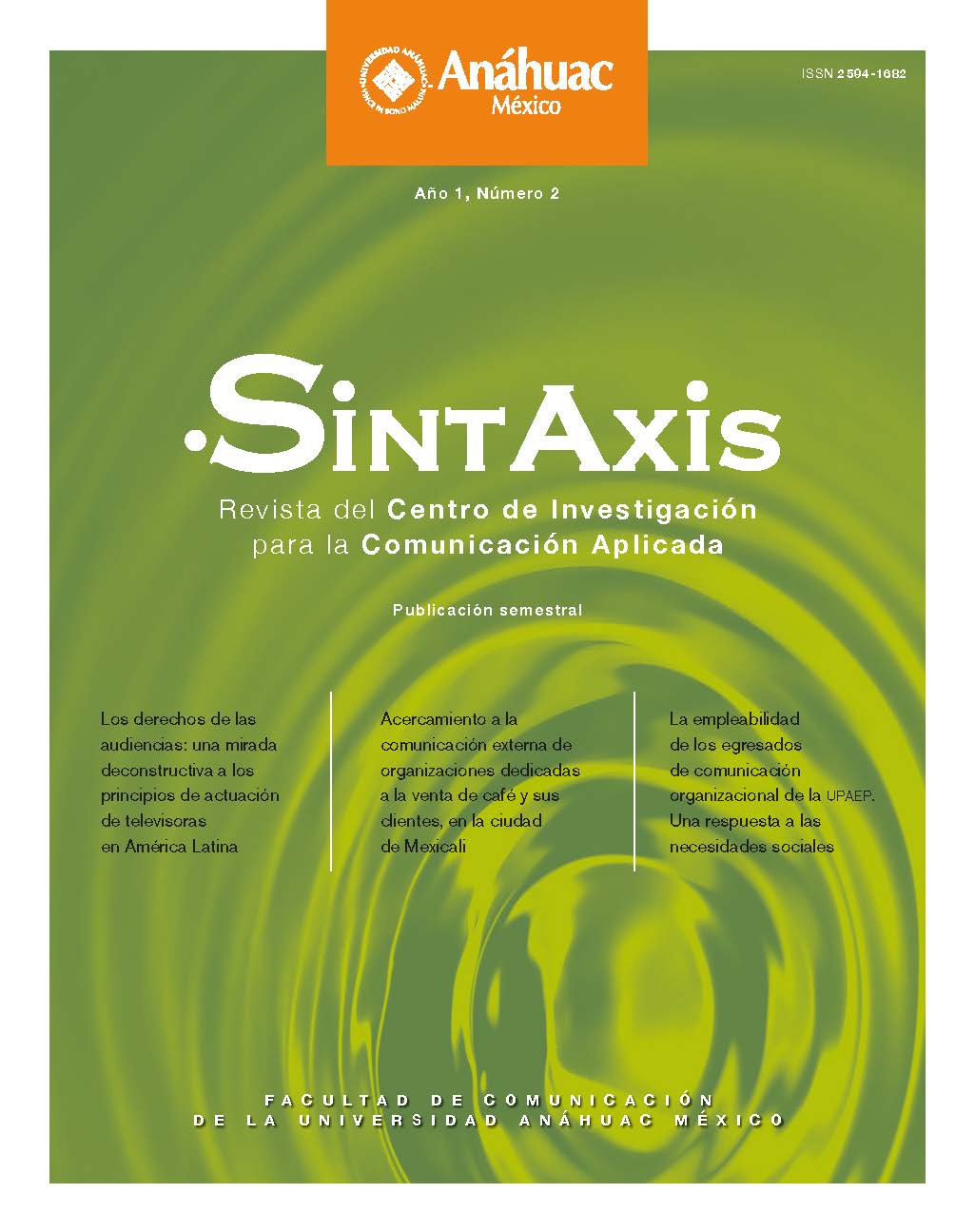The rights of audiences: a deconstructive look at the principles of television performance in Latin America
Main Article Content
Abstract
This study makes a deconstructive analysis of the principles of action of television stations in Latin America, in order to highlight the paradoxes that make up the being and the performance of the industry with the greatest influence in society. The deconstruction is a political gesture that responds to the debt with the heteronomous justice. So, the objective is to deconstruct the operational frameworks and to know how important it is for television broadcasters to publish the rights of the audiences. This study shows that no television station, from a sample of 10 companies, complies with the commitment to publish on its web pages the rights of audiences proclaimed by different organizations, such as the United Nations Organization, and other international bodies responsible for establishing Fundamental rights of the human being, which shows us that the television channels are managed according to their own interests, and not as a service of public interest in favor of democracy. This study shows, therefore, that television is not an ally in the formation of a participatory citizenship.
Downloads
PLUMX Metrics
Article Details
The author keeps the property rights with no restriction whatsoever and guarantees the magazine the right to be the first publication of the work. The author is free to deposit the published version in any other medium, such as an institutional archive or on his own website.
References
Baudrillard, J. (2000). Pantalla Total. Barcelona, España: Anagrama.
Bauman, Z. (2004). La Sociedad Sitiada. Buenos Aires, Argentina: Fondo de Cultura Económica.
Byun-Chul, H. (2012). La sociedad del cansancio. Barcelona, España: Herder.
Bourdieu, P. (2010). Sobre la televisión. Barcelona, España: Anagrama.
Canal Uno. (2016). Programación: Canal Uno. Recuperado el 21 de abril de 2016, de http://www.canal1tv.com/
Caracol. (2016). Código de Autorregulación: Asomedios Presidencia. Recuperado el 23 de abril de 2016, de http://static.caracoltv.com.s3.amazonaws.com/archivos/CODIGODEAUTORREGULACION- ASOMEDIOSDEF.01.02.2012doc.pdf
Caracol Televisión. (2012). Portal Corporativo: Caracol Televisión. Recuperado el 21 de abril de 2016, de http://www.caracoltvcorporativo.com/
Constitución Política de los Estados Unidos Mexicanos. (2017). Constitución publicada en el Diario Oficial de la Federación el 5 de febrero de 1917. Texto vigente. Última reforma publicada dof 24-02-2017. Recuperado el 12 de marzo de 2017, de http://www.diputados.gob.mx/LeyesBiblio/ref/cpeum.htm
Convención sobre los Derechos del Niño. (1989). Recuperado el 12 de marzo de 2017, de http://www.derechosinfancia.org.mx/Derechos/conv_3.htm
Del Prado, R. (2016). Ética y los derechos de las audiencias. Ciudad de México, México: Limusa.
Derrida, J. (1995). Espectros de Marx. Madrid, España: Trotta.
Derrida, J. (1998). Ecografías de la televisión. Buenos Aires, Argentina: Eudeba. Universidad de Buenos Aires.
Fuente-Cobo, C., Martínez-Otero, J., & Del Prado, R. (2014). “Las audiencias activas en la regulación de los medios: La dialéctica consumidor-ciudadano en España y México”. Comunicar Revista Científica de Educomunicación, 43(XXII), 91-99.
Grupo Globo. (2019). Esencia Globo: Grupo Globo. Recuperado el 20 de junio de 2019, de https://grupoglobo.globo.com/es/principios-editoriais/
Luhmann, N. (2007). La realidad de los medios de masas. Barcelona, España: Anthropos, Universidad Iberoamericana.
Organización de los Estados Americanos. (1969). Convención Americana sobre Derechos Humanos: Departamento de Derecho Internacional. Recuperado el 16 de enero de 2016, de
http://www.oas.org/dil/esp/tratados_B32_Convencion_Americana_sobre_Derechos_Humanos.htm
Organización de los Estados Americanos. (20 de octubre de 2000). Declaración de Principios sobre Libertad de Expresión: Comisión Interamericana de Derechos Humanos. Recuperado de
http://www.oas.org/es/cidh/mandato/Basicos/PrincipiosLE.asp
UNESCO. (1978). Declaración sobre los Principios Fundamentales relativos a la Contribución de los Medios de Comunicación de Masas al Fortalecimiento de la Paz y la Comprensión Internacional, a la Promoción de los Derechos Humanos y a la Lucha contra el Racismo, el Aparth. Recuperado el 11 de enero de 2012, de http://portal.unesco.org/es/ev.php-URL_ID=13176&URL_DO=DO_
TOPIC&URL_SECTION=201.html
Televisa. (2014). Quiénes somos, Corporativo: Televisa. Recuperado el 28 de abril de 2016, de
http://www.televisa.com/corporativo/quienes-somos/
Televisión Nacional. (2016). TVN CORPORATIVO: Televisión Nacional. Recuperado el 21 de abril de 2016, de http://www.tvn.cl/corporativo/
Televisión Nacional Uruguay. (2016). Institucional: Televisión Nacional Uruguay. Recuperado el 26 de abril de 2016, de http://www.tnu.com.uy/institucional
Trece TV. (2016). Términos de eltrecetv.com: Trece TV. Recuperado el 21 de abril de 2016, de
http://www.eltrecetv.com.ar/terminos
TV Azteca. (2016). TV Azteca. Recuperado el 21 de abril de 2016, de http://www.tvazteca.com/
TV Perú. (2016). Instituto Nacional de Radio y Televisión de Perú: TV Perú. Recuperado el 21 de abril de 2016, de http://www.irtp.com.pe/
Tves. (2016). Somos Tves: Tves. Recuperado el 21 de abril de 2016, de http://tves.sv/somos-tves/
Vargas Llosa, M. (2012). La civilización del Espectáculo. Estado de México, México: Alfaguara.
Venezolana de Televisión. (2016 ). Inicio: Venezolana de Televisión. Recuperado el 23 de abril de 2016, de http://www.vtv.gob.ve/

